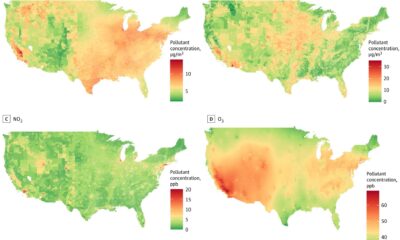Health
Research shows that safe access to food and water for American children is declining

Credit: Unsplash/CC0 public domain
Between 2005 and 2020, the number of children experiencing concurrent water and food insecurity in the United States more than doubled. Additionally, black and Hispanic children were several times more likely than white children to experience food and water insecurity simultaneously.
This is according to new research from Asher Rosinger, associate professor of biobehavioral health and anthropology at Penn State, and Sera Young, associate professor of anthropology at Northwestern University.
In a study published in Natural waterthe researchers examined water insecurity, food insecurity, and their co-occurrence among children in the United States.
The researchers analyzed data from 18,252 children using the National Health and Nutrition Examination Survey (NHANES)a nationally representative assessment of health and nutrition conducted annually since 1999 and sporadically since the 1960s.
Water insecurity or food insecurity – the lack of consistent, safe access to food or water – can be devastating to healthy growth, according to the researchers. Water insecurity is associated with issues in mental health, physical health, nutrition and economic well-being. Food insecurity is linked to poor mental health, diabetes, poor nutrition, obesity, cardiovascular disease and premature death.
Around the world, food and water insecurity are often caused by poverty, insufficient access to resources and climate-related problems, the researchers said.
In high-income countries such as the US, food and water insecurity can be caused by a range of circumstances, including sudden loss of income, family instability or infrastructure problems. While this is much more common at lower income levels, the researchers say water and food insecurity in the US is much more common than expected
A growing concern
In 2005-2006, 4.6% of all children in the United States experienced both water and food insecurity. During the 2017-2020 survey cycle, researchers found that the percentage of children nationwide experiencing both issues increased to 10.3%.
Over the course of the 20th century, rates of both food insecurity and water insecurity have generally improved, said Rosinger, who directs the Penn State College of Health and Human Development Environmental Health Sciences Program and directs the Water, Health and Nutrition Lab. However, during the period of this study, researchers found a steady, gradual increase in household food insecurity.
Water insecurity fluctuated between 2005 and 2013. Then the 2013 water crisis in Flint, Michigan, made national news. Between 2013 and 2020, the risk of water insecurity – measured by whether children do not drink their tap water – increased by 88%.
According to the researchers, water and food problems are inherently linked. The authors’ previous work showed the link between water and food insecurity in adults, and this paper showed that children who avoided tap water were more likely to experience food insecurity as well.
Avoiding tap water is associated with other problems that can negatively affect food and water intake, Rosinger said. People who avoid tap water are less likely to cook nutritious food for their children because they don’t have a reliable water source in the kitchen taps. People who avoid tap water also consume more sugary drinks. In addition, they may have less money for nutritious food because they buy bottled water, which is much more expensive.
“Nearly one in 10 children experienced household food insecurity and avoided tap water in 2020, and we know the COVID-19 pandemic has only exacerbated food insecurity,” Rosinger said. “That means millions of children in this country face potential negative consequences for their mental health, physical health and economic future.”
Major racial differences
Compared to the national average, the numbers among Spanish-speaking children are much higher, according to the researchers. Their results showed that black children were 3.5 times more likely than white children to experience food and water insecurity at the same time. Hispanic children, meanwhile, were more than seven times more likely than white children to experience food and water insecurity at the same time.
While the availability of safe, reliable access to water is a critical part of water safety, trust in piped water is also a factor, for both children and their parents. The researchers said that if parents don’t trust the water, they are less likely to give it to their children for fear it will make them sick.
“Most people are aware that Flint, Michigan, has experienced a crisis related to unsafe tap water, and Flint is a predominantly black community,” Rosinger said.
“Since then, there have been other highly visible problems with water systems in majority-minority communities such as Newark, New Jersey and Jackson, Mississippi. If you see on the news that people who look like you are getting sick from tap water, it can increase mistrust. In addition, minority groups often have poorer access to services, especially those living in low-income communities.”
Rosinger described reports of people being told brown water from the tap was safe to drink. “But smell, taste and color influence whether people trust their water,” he said. “This mistrust is rational and must be addressed.”
Understanding water insecurity
The NHANES data include measures of food insecurity, but water insecurity was not directly assessed in the study. To understand when children encountered water insecurity, the researchers found a variable that functioned as a proxy for water insecurity: avoidance of tap water. Rosingers previous research showed that avoiding tap water can provide a window into understanding water insecurity.
“At all but the very lowest income levels, children were more likely to experience food insecurity if they did not drink tap water,” Rosinger said.
“We saw the largest effect for children in low-income and lower-middle-income households, but even in households earning incomes several times higher than the national poverty level, children were more likely to experience food insecurity if they did not drink tap water. “
According to the analyses, children in households below the poverty line had a very high risk of food insecurity, regardless of whether they drank tap water or not.
The researchers say global water insecurity is expected to increase in coming years due to pressures from climate change, population growth and aging infrastructure. While they said data on tap water avoidance is useful, they believe directly measuring experiences of water insecurity is important.
“We can’t manage what we can’t measure,” Young said. “The first step is to understand the scale of the problem. Avoiding piped water is a good indicator of water insecurity, but it is clear that we need a better understanding of who is experiencing hardship and the extent of that hardship.”
Young led the development of the Water Insecurity Experiences Scale (WISE), an innovative instrument designed to measure universal experiences of water insecurity and inform development actions and policy implementation. The WISE scale surveys individuals on twelve experiences with water access, use, and reliability.
The tool has been used to collect nationally representative data on water insecurity from at least 40 low-, middle-, and high-income countries, including among U.S. adults, but has not been adopted by the U.S. National Health Service at the time of this publication. and nutrition research survey.
Moving forward
Despite the lack of a direct measure of water insecurity in the US, researchers agreed that much can be done right now to address water and food security in the country. They said government programs such as the Special Supplemental Nutrition Program for Women, Infants and Children (WIC) and the Supplemental Nutrition Assistance Program (SNAP), which have been shown to reduce food insecurity, could be expanded.
“Right now, many people in the U.S. equate the existence of water infrastructure with water being safe,” Young said. “But tap water can be unaffordable, contaminated, dried up, or otherwise unavailable. And let’s not forget that there are millions of people in the U.S. living without tap water.”
The researchers said policy changes could reverse the trend of increasing water insecurity. They said providing water filters to Spanish households has already been shown to reduce distrust of tap water, resulting in increased tap water consumption and reduced reliance on bottled water. The researchers also advocated home water testing to assess water safety.
“Although there are several million people without safe and reliable drinking water, 99% of American households have piped access to water in their home, and the vast majority of that water is clean and drinkable,” Rosinger said, noting that The US has one of the best water distribution systems in the world.
“To rebuild confidence in this system, we need to conduct tests to prove that water is safe. We need to replace lead plumbing pipes and install filters where water is not safe. These actions will ensure that our nation’s children have access to the clean water they need. must grow and prosper and that their families do not experience additional financial and mental stress due to uncertain water quality.”
More information:
Asher Y. Rosinger et al., Trends and differences in concurrent tap water avoidance and household food insecurity among US children, Natural water (2024). DOI: 10.1038/s44221-024-00261-2
Quote: Safe access to food and water is declining for US children, survey findings (2024, June 7) retrieved June 7, 2024 from https://medicalxpress.com/news/2024-06-access-food-decreasing-children.html
This document is copyrighted. Except for fair dealing purposes for the purpose of private study or research, no part may be reproduced without written permission. The content is provided for informational purposes only.













